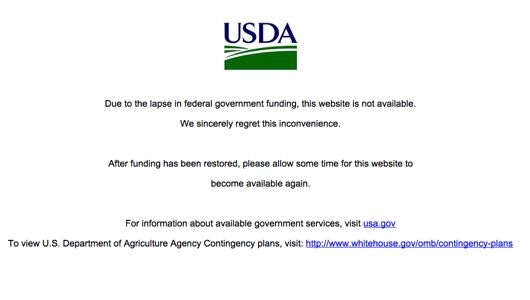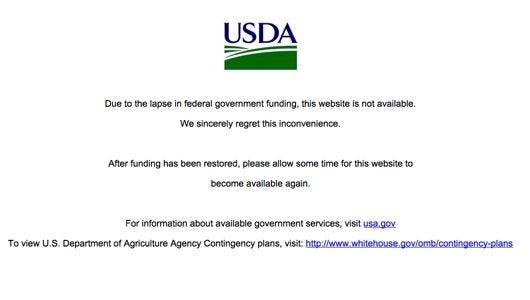
WITH more that 800,000 federal workers off the job as Congress wrangles over the budget, agricultural producers, traders and analysts are flying relatively blind, underscoring the amount of sensitive market data provided by the U.S. Department of Agriculture and Commodity Futures Trading Commission (CFTC).

This image greeted visitors to USDA websites after the government funding lapse Oct. 1, and will remain until the government is back up and running again.
While federal food safety inspectors were unaffected by the shutdown – designated as “essential” in the Department’s contingency plans – USDA’s Agricultural Marketing Service (AMS), National Agricultural Statistics Service (NASS) and Economic Research Service (ERS) are all on the sidelines until Congress passes a continuing resolution to fund the government. Reports such as the weekly Broiler Hatchery report were not released this week, and should the shutdown persist, it could scrap the monthly Crop Production report and World Agricultural Supply and Demand Estimates due to be released Oct. 11.
For the beef biz, the more immediate disruption in market data is the absence of AMS’ daily livestock slaughter and price reporting data.
“As it stands, there will be no publication of livestock slaughter or prices,” wrote economists Steve Meyer and Len Steiner at the Daily Livestock Report. “Markets will continue to function and trades will no doubt be made, but buyers and sellers will not have the normal publicly-available data from which to gauge offers and bids.”
Furthermore, USDA took the unprecedented step of completely shutting down its website Tuesday, withholding historical data from the market as well. A scan of other cabinet-level department websites indicated that most, if not all, were still online, most with the caveat that information was not being updated during the shutdown and that some functions would be limited or unavailable.
Sources familiar with USDA’s operations told me that USDA hosts and operates its website in-house, perhaps leading to the site going dark while works were furloughed. Others, seeing a purely political motive, recalled former White House chief of staff Rahm Emanuel’s infamous quip about not letting a good crisis go to waste.
One Hill aggie familiar with the Department's operations speculated that federal agencies were only allowed to keep a certain number or percentage of their staff on as "essential" during the shutdown, meaning that staffers necessary to ensure the security of USDA's online data could not be "excepted" as part of USDA's contingency planning. As of this writing, USDA's lone working communications staffer had not returned requests for an explanation.
Stemming from missing AMS price and slaughter reporting, CME Group announced several potential issues this week related to the lack of USDA data, and temporarily suspended calculation of its lean hog and feeder cattle indexes. The exchange confirmed Thursday that both live and carcass grading performed by USDA graders will be available as needed for all live cattle deliveries against the October 2013 Live Cattle Contract, and said that at this point, for any cattle deliveries occurring during the government shutdown, the most recently issued reports by the USDA for adjustment factors will be used for calculating final invoice amounts for live and carcass deliveries.
How long the shutdown drags on could disrupt settlement of CME’s October cattle contracts, as well. Speaking at the National Chicken Council’s annual meeting in Washington, D.C., last week, Delaware Senator Chris Coons said he expected the shutdown to last at least another week, a sentiment echoed by other Capitol Hill sources late last week.
Perhaps most concerning relative to the commodities futures market, CFTC will not publish its Commitment of Trader and other similar reports, keeping the market in the dark about the positions of other producers, consumers and speculators. Of its 680 employees, just 28 CFTC officials were “excepted” from the shutdown, considered essential to carrying out the Commission’s oversight and enforcement activities.
The absence of federal data of interest to the agricultural commodities market underscored the reliance of the market on those data functions. Private industry sources such as CattleFax, Express Markets and Urner-Barry provide some beef and poultry pricing and supply data to subscribers, the breadth, depth and cost (free) of USDA’s offerings to the public are hard to under-appreciate at this point.
You can read more on this situation at Feedstuffs.com, and in the Oct. 7 edition of Feedstuffs.
About the Author(s)
You May Also Like




